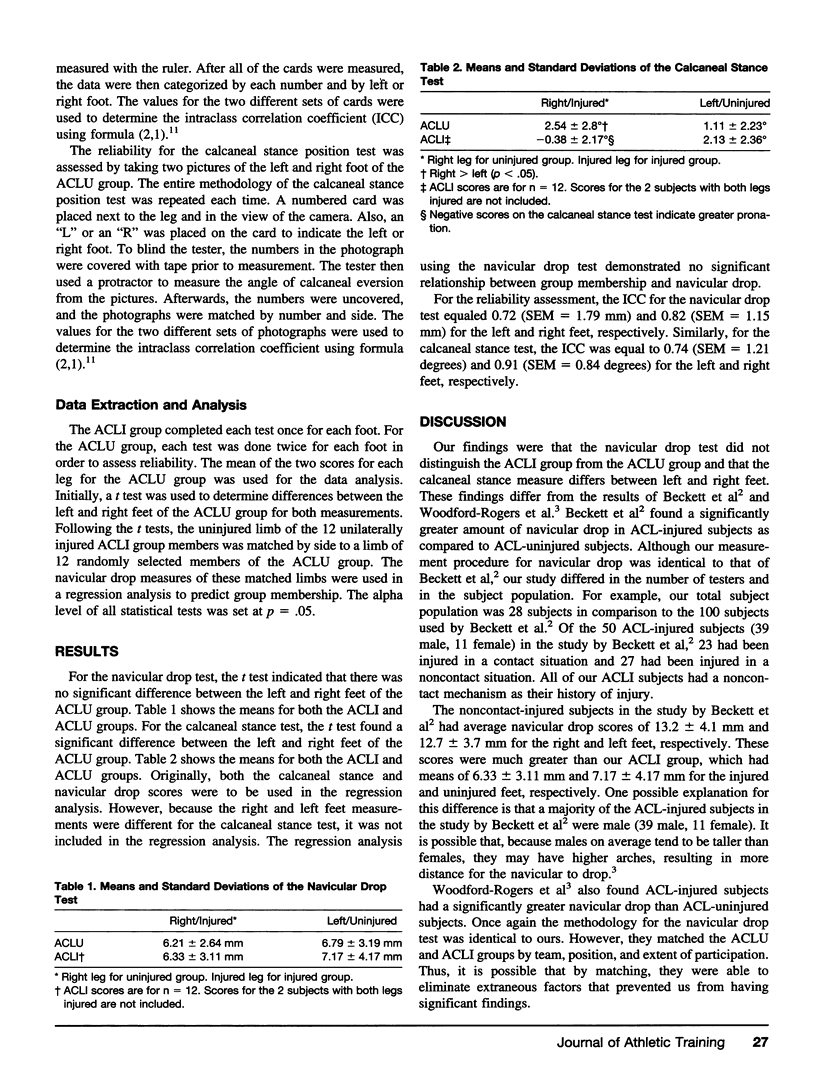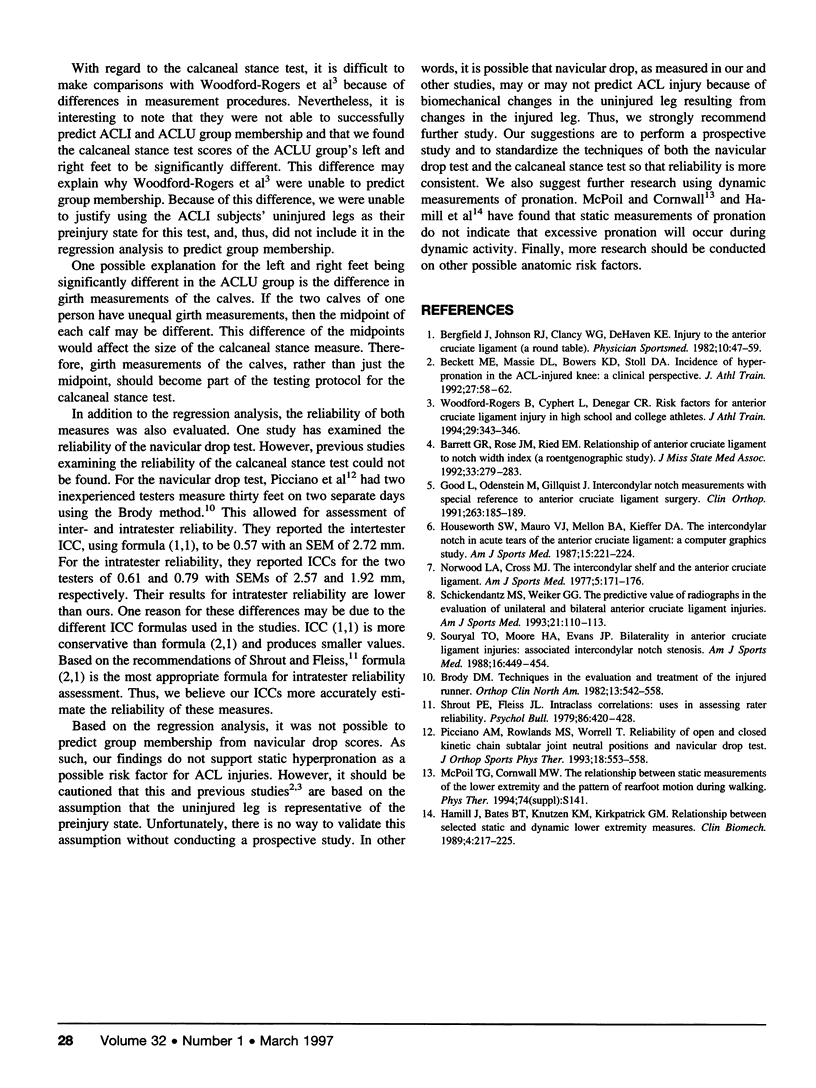Abstract
Objective:
The purpose of this study was to examine the relationship between hyperpronation and the occurrence of noncontact injury to the anterior cruciate ligament (ACL).
Design and Setting:
Subjects were categorized as either ACL injured (ACLI) or ACL uninjured (ACLU). All ACLI subjects received their injuries from a noncontact mechanism. To justify using the ACLI subjects' uninjured legs as representative of their preinjury state, a t test was used to compare the differences between the left and right foot for the ACLU group on both measurements. Based on the results of the t test, a regression analysis was performed to determine whether group membership could be predicted from navicular drop. All measures were performed in a university athletic training room.
Subjects:
Fourteen ACLI subjects (age = 21.07 ± 0.83 yr, ht = 174.81±8.29 cm, wt = 72.32±13.47 kg) and 14 ACLU subjects (age = 21.14±2.03 yr, ht = 177.35±11.31 cm, wt = 72.99±14.81 kg) participated.
Measurements:
Hyperpronation was assessed via the navicular drop test and the calcaneal stance test.
Results:
No significant difference (p > .05) between feet for the navicular drop test was found. However, there was a significant difference (p < .05) between feet for the calcaneal stance test, and, thus, this measure was not used in the regression analysis. Using the navicular drop score, the regression analysis was unable to predict group membership.
Conclusions:
Hyperpronation as measured by the navicular drop test was not a predictor of ACL injury, and, thus, may not be a predisposing factor to noncontact ACL injuries.
Keywords: anterior cruciate ligament, hyperpronation, risk factors
Full text
PDF



Images in this article
Selected References
These references are in PubMed. This may not be the complete list of references from this article.
- Barrett G. R., Rose J. M., Ried E. M. Relationship of anterior cruciate ligament injury to notch width index (a roentgenographic study). J Miss State Med Assoc. 1992 Aug;33(8):279–283. [PubMed] [Google Scholar]
- Beckett M. E., Massie D. L., Bowers K. D., Stoll D. A. Incidence of Hyperpronation in the ACL Injured Knee: A Clinical Perspective. J Athl Train. 1992;27(1):58–62. [PMC free article] [PubMed] [Google Scholar]
- Brody D. M. Techniques in the evaluation and treatment of the injured runner. Orthop Clin North Am. 1982 Jul;13(3):541–558. [PubMed] [Google Scholar]
- Good L., Odensten M., Gillquist J. Intercondylar notch measurements with special reference to anterior cruciate ligament surgery. Clin Orthop Relat Res. 1991 Feb;(263):185–189. [PubMed] [Google Scholar]
- Houseworth S. W., Mauro V. J., Mellon B. A., Kieffer D. A. The intercondylar notch in acute tears of the anterior cruciate ligament: a computer graphics study. Am J Sports Med. 1987 May-Jun;15(3):221–224. doi: 10.1177/036354658701500305. [DOI] [PubMed] [Google Scholar]
- McPoil T., Cornwall M. W. Relationship between neutral subtalar joint position and pattern of rearfoot motion during walking. Foot Ankle Int. 1994 Mar;15(3):141–145. doi: 10.1177/107110079401500309. [DOI] [PubMed] [Google Scholar]
- Norwood L. A., Jr, Cross M. J. The intercondylar shelf and the anterior cruciate ligament. Am J Sports Med. 1977 Jul-Aug;5(4):171–176. doi: 10.1177/036354657700500406. [DOI] [PubMed] [Google Scholar]
- Picciano A. M., Rowlands M. S., Worrell T. Reliability of open and closed kinetic chain subtalar joint neutral positions and navicular drop test. J Orthop Sports Phys Ther. 1993 Oct;18(4):553–558. doi: 10.2519/jospt.1993.18.4.553. [DOI] [PubMed] [Google Scholar]
- Schickendantz M. S., Weiker G. G. The predictive value of radiographs in the evaluation of unilateral and bilateral anterior cruciate ligament injuries. Am J Sports Med. 1993 Jan-Feb;21(1):110–113. doi: 10.1177/036354659302100118. [DOI] [PubMed] [Google Scholar]
- Souryal T. O., Moore H. A., Evans J. P. Bilaterality in anterior cruciate ligament injuries: associated intercondylar notch stenosis. Am J Sports Med. 1988 Sep-Oct;16(5):449–454. doi: 10.1177/036354658801600504. [DOI] [PubMed] [Google Scholar]
- Woodford-Rogers B., Cyphert L., Denegar C. R. Risk factors for anterior cruciate ligament injury in high school and college athletes. J Athl Train. 1994 Dec;29(4):343–346. [PMC free article] [PubMed] [Google Scholar]




